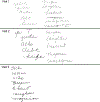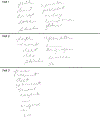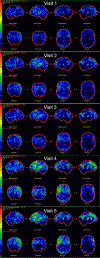Prominent auditory deficits in primary progressive aphasia: A case study
- PMID: 30878181
- PMCID: PMC6650352
- DOI: 10.1016/j.cortex.2019.01.021
Prominent auditory deficits in primary progressive aphasia: A case study
Abstract
Aphasia typically is associated with comparable difficulties in written and spoken modalities of language expression and comprehension. In contrast, auditory verbal agnosia is the disproportionate difficulty comprehending spoken compared to written language, also typically greater than difficulties with spoken and written language expression, in the absence of a primary sensory deficit. The terms pure word deafness and auditory verbal agnosia are often used synonymously. However, the broader term of auditory agnosia more accurately reflects difficulty processing both speech and non-speech sounds whereas individuals with auditory verbal agnosia (pure word deafness) have preserved processing of environmental sounds. Auditory agnosia is reported in the stroke literature, but rarely reported in progressive neurologic disorders. Here, we report a case of a woman who presented with what is best described as a prominent auditory deficit in the context of an initially unclassifiable, or mixed, primary progressive aphasia (PPA) with accompanying apraxia of speech. Her clinical presentation shared features with auditory agnosia, although sensory functioning was not formally assessed. We report clinical and neuroimaging data spanning 6 years and subsequent autopsy results. She presented at 65 years of age, 5 years post onset of symptoms that included insidious and progressive difficulties thinking of words, constructing sentences, pronouncing words, and understanding instructions. She had disproportionate difficulty with comprehension of spoken compared to written language. She eventually developed features of the nonfluent/agrammatic variant of PPA, as well as an apraxia of speech. Imaging with [18F]-fluorodeoxyglucose (FDG)-PET revealed progression of bilateral (left greater than right) hypometabolism involving the frontal, temporal (predominantly the lateral superior gyrus), and parietal lobes, that eventually included the supplementary motor area, anterior cingulate, and caudate. Autopsy revealed pathological lesions consistent with corticobasal degeneration.
Keywords: Auditory agnosia; Corticobasal degeneration; Frontotemporal dementia; PET; Primary progressive aphasia.
Copyright © 2019 Elsevier Ltd. All rights reserved.
Conflict of interest statement
Declaration of Interest
The authors report no conflicts of interest.
Figures





Comment in
-
Auditory symptoms in primary progressive aphasia: A commentary on Utianski et al. (2019).Cortex. 2019 Oct;119:580-582. doi: 10.1016/j.cortex.2019.03.023. Epub 2019 Apr 10. Cortex. 2019. PMID: 31030898 No abstract available.
References
-
- Auerbach SH, Allard T, Naeser M, Alexander MP, & Albert ML (1982). Pure word deafness. Analysis of a case with bilateral lesions and a defect at the prephonemic level. Brain, 105(Pt 2), 271–300. - PubMed
-
- Ceccaldi M, Soubrouillard C, Poncet M, & Lecours AR (1996). A case reported by Serieux: The first description of a “primary progressive word deafness?”. Classic cases in neuropsychology, 45–52.
Publication types
MeSH terms
Grants and funding
LinkOut - more resources
Full Text Sources
Other Literature Sources

